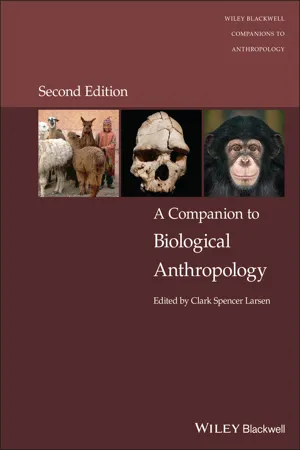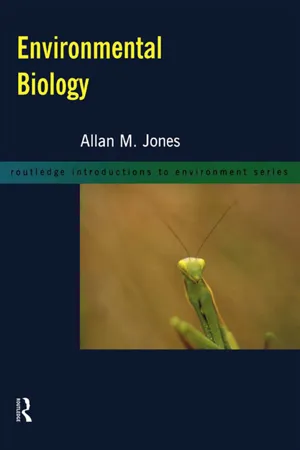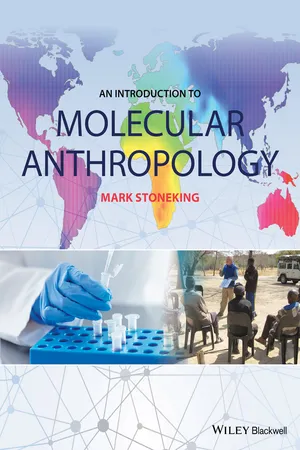Biological Sciences
Population Genetics
Population genetics is the study of genetic variation and its distribution within populations. It explores how genetic traits change over time due to factors like natural selection, genetic drift, and gene flow. By understanding the genetic makeup of populations, population genetics provides insights into evolutionary processes and helps in the conservation of species.
Written by Perlego with AI-assistance
Related key terms
4 Key excerpts on "Population Genetics"
- eBook - ePub
- Clark Spencer Larsen, Clark Spencer Larsen(Authors)
- 2023(Publication Date)
- Wiley-Blackwell(Publisher)
CHAPTER 5 Diversity, Ancestry, and Evolution: The Genetics of Human Populations John H. Relethford INTRODUCTION Population Genetics is the mathematical theory of genetic changes in a population from one generation to the next. Like Mendelian genetics, Population Genetics is also concerned with the transmission of genetic information from one generation to the next – but for the entire breeding population, and not just for a specific pair of mates. The underlying models of Population Genetics can be applied to all organisms, including humans. The study of the genetics of human populations also incorporates the cultural dimension of human existence. The study of human Population Genetics today includes research on genetic diversity within and among populations, patterns of genetic ancestry and history in populations, the long-term evolution of the human species, and selection and genetic adaptation. Population Genetics theory looks at genetic change in a population by focusing on the frequency of different alleles (the different forms of a gene or DNA sequence) and on the way these frequencies change over time. Imagine, for example, that you are looking at the frequencies of two alleles, A and B, for a hypothetical genetic locus. You visit a population and you note that the frequency of the A allele is 60 percent and the frequency of the B allele is 40 percent. Assume that you come back a generation later to find that the frequencies of these alleles are now 58 percent A and 42 percent B. A small amount of evolution has taken place – the frequency of A has gone down a little bit and the frequency of B has gone up. Population Genetics looks at the mechanisms by which this type of allele frequency change could take place. Studies of genetic variation within and among populations can then provide data to confirm the mechanism(s) of evolutionary change by comparing reality with theoretical expectations, a standard method of scientific research - eBook - ePub
- Allan M. Jones(Author)
- 2006(Publication Date)
- Routledge(Publisher)
PopulationsKey concepts- Genetic variation is related to the method/s of reproduction in a species. Sexual reproduction results in genetic mixing.
- Genetic variation within a population gene pool is the working material for natural selection.
- Inbreeding results in reduced variation within the gene pool while outbreeding increases it.
- Many factors influence the genotypes and gene frequencies of populations and small populations are particularly susceptible.
- Speciation is the result of mechanisms which isolate populations from gene flow.
- Populations of a species occupy a niche but its members are distributed in space (dispersion patterns) and vary in age and size (population structure).
- Environments have a finite carrying capacity (K).
- Populations are subject to both density-dependent and density-independent controls.
- Intraspecific and interspecific relationships are dominated by competition and by predator– prey interactions.
Populations are groups of individuals of the same species living in a defined geographical area. These individuals share many morphological, physiological and behavioural characters but no two individuals are ever exactly the same, although clonal forms produced by asexual reproduction or parthenogenesis will be extremely similar. Even genetically identical individuals may vary due to differences arising during growth and development. It is this variation that provides the raw material for natural selection. The aim of this chapter is to describe and discuss the characteristics of populations and the parameters, both internal and external, which exert control upon them.6.1 Ecological geneticsNatural selection - eBook - ePub
- Mark Stoneking(Author)
- 2016(Publication Date)
- Wiley-Blackwell(Publisher)
CHAPTER 3 Genes in PopulationsHaving covered how genes are inherited, as well as what they are, what they do, and how they do it, we are now ready to tackle how genes behave in populations. In case you are wondering, understanding how genes behave in populations is necessary for understanding how evolution influences genes, which in turn is important for trying to infer what happened in the past from patterns of genetic variation in populations living today—which is, to remind you, a major goal of molecular anthropology. So, in this chapter we will cover some important concepts about populations, while the next two chapters will discuss how genes behave in populations, and the various evolutionary forces and how they influence genetic variation within populations and genetic differences between populations. From an historical perspective, all of this information could have come before the preceding chapter on molecular genetics, because all of the ideas and concepts about genes in populations and how their variation is influenced by evolutionary forces were worked out long before anyone knew what a gene actually was. However, knowing something about what genes are does aid in understanding the ideas and concepts presented in this and subsequent chapters.What is a Population?
As we shall see in later chapters, many of the analyses that molecular anthropologists carry out are performed on data collected from populations. A critical aspect of these analyses, that often does not get enough attention, is determining who belongs to which population. So, let's start by defining what we mean by a population. Here is the scientific definition of the term “population”: a spatial–temporal group of interbreeding individuals who share a common gene pool. This is a great example of how scientists like to do things: take a word for which everyone has at least some idea of the meaning (like “population”) and define it with terms that nobody ever uses! But let's break down the terms and see what is going on. First, what is meant by “spatial–temporal”? Simply that a population occupies a particular geographic area (the spatial) and does so over a (relatively) long period of time (the temporal). So, assuming that you are reading this book because it is an assigned text for a particular class, we wouldn't consider you and your classmates to be a population, because even though you assemble regularly at one specific location (viz., the classroom or lecture hall), after class is over you disperse to other locations. - eBook - ePub
- Joanna R. Freeland(Author)
- 2019(Publication Date)
- Wiley(Publisher)
It should be apparent from the preceding examples that population boundaries are seldom precise, although in many cases should correspond more or less to the distribution of potential mates. When beginning a research project, biologists often identify discrete populations as part of the framework they are using for their sampling design, which should specify parameters such as the minimum number of individuals that need to be sampled from each presumed population. Nevertheless, populations are not necessarily clear‐cut units, and the boundaries are sometimes revised after additional ecological or genetic data have been acquired. Bearing in mind that molecular ecology is primarily concerned with wild populations, which by their very nature are variable and often unpredictable, we shall now start to look at ways in which molecular genetics can help us to understand the dynamics of single populations.Quantifying Genetic Diversity
The genetic diversity of a population refers to the numbers of different alleles that are collectively contained within all individuals, and is one of the most important attributes of any population. Environments are constantly changing, and diversity is necessary if populations are to continuously evolve and adapt to new situations. This is intuitively obvious, because evolution can act only on existing levels of variation. It should therefore not be surprising to learn that a link between genetic diversity and the resilience of populations has been made in numerous quantitative studies. For example populations of the threatened, predominantly clonal seagrass Posidonia australis with relatively high levels of genetic diversity also had relatively high levels of variation in morphological traits and shoot productivity (Evans et al. 2016 ). Meadows of another clonal seagrass, Zostera noltii, with relatively high levels of genetic diversity were better able to resist environmental perturbations than meadows that harbored low levels of diversity (Massa et al. 2013 ). More generally, a review of 31 experimental and 14 comparative studies across a range of taxonomic groups found that populations and species with relatively high levels of genetic variation were less vulnerable to environmental change and less prone to extinction. In addition, they had more stable population sizes, experienced greater success in establishing new populations, and had larger geographic distributions (Forsman and Wennersten 2016 ). The genetic diversity of populations can also directly affect the communities and ecosystems in which they live. Fourtune et al. (2016 ) used a combination of electric‐fishing and microsatellite genotyping to determine that the species diversity of a fish community was correlated with genetic diversity in each of four freshwater fish species (so‐called species–genetic diversity correlations , or SGDCs ), a pattern that is likely explained by a combination of historical process (e.g. colonization histories) and current environmental conditions. In Chapter 8
Learn about this page
Index pages curate the most relevant extracts from our library of academic textbooks. They’ve been created using an in-house natural language model (NLM), each adding context and meaning to key research topics.



